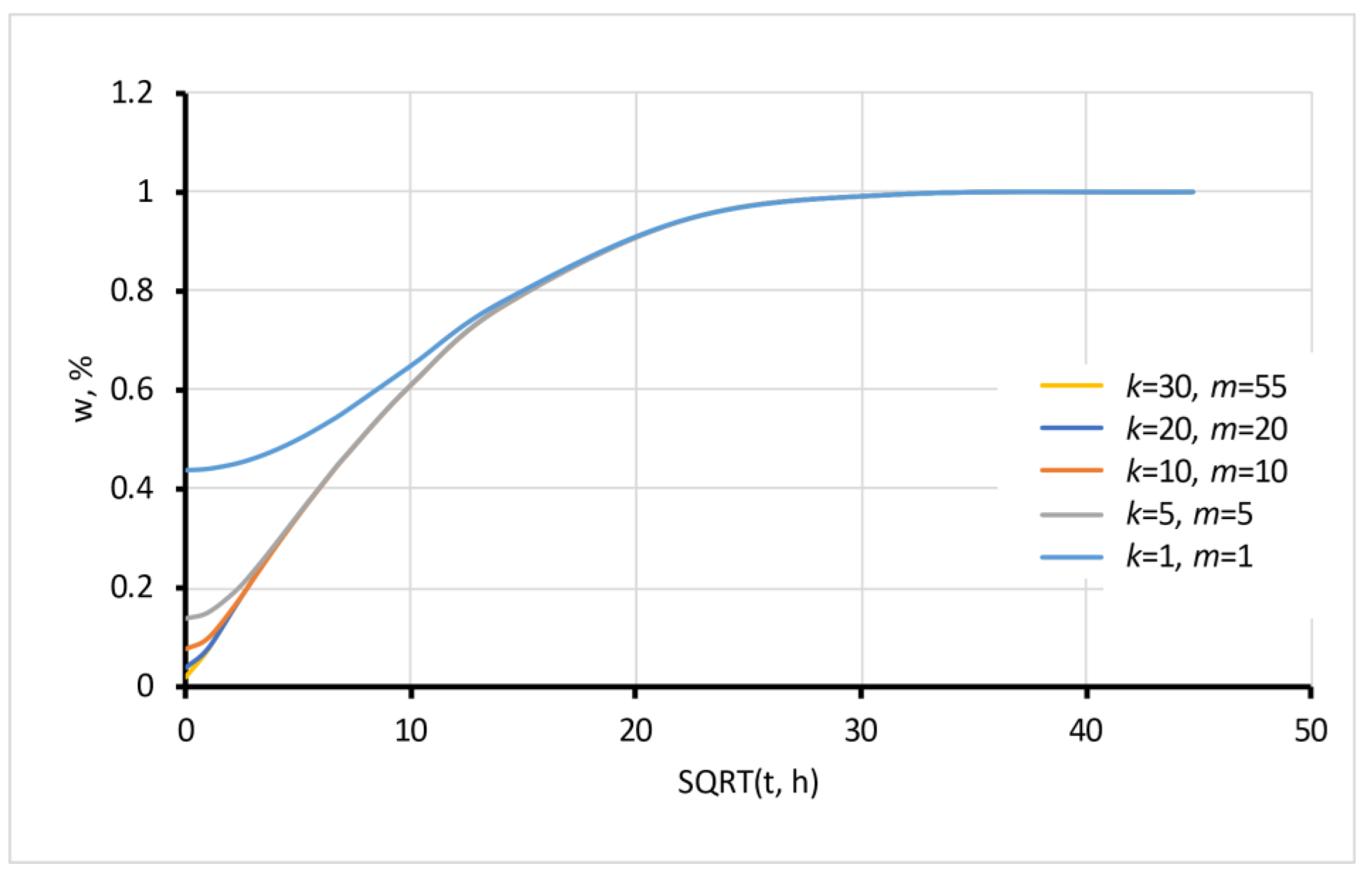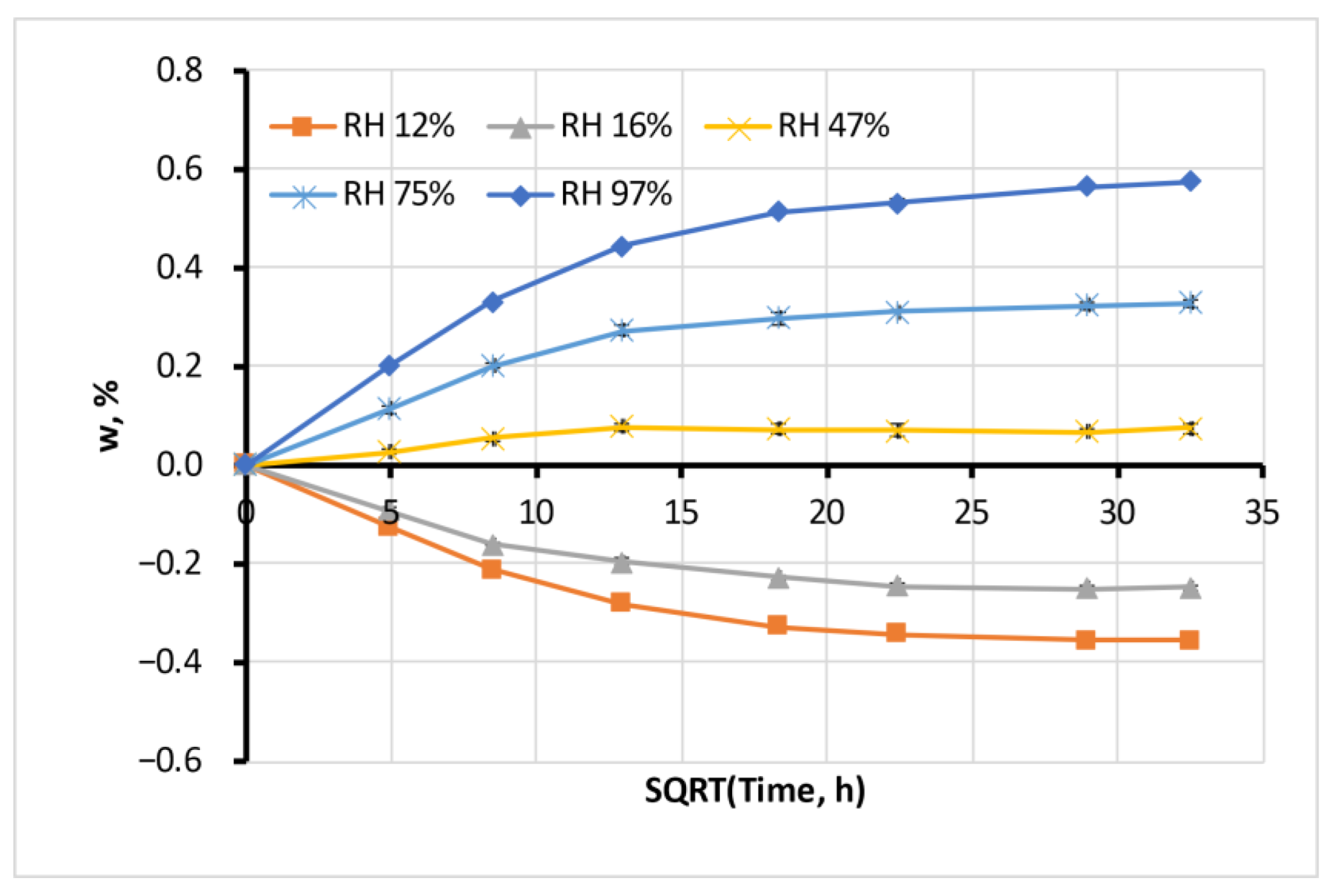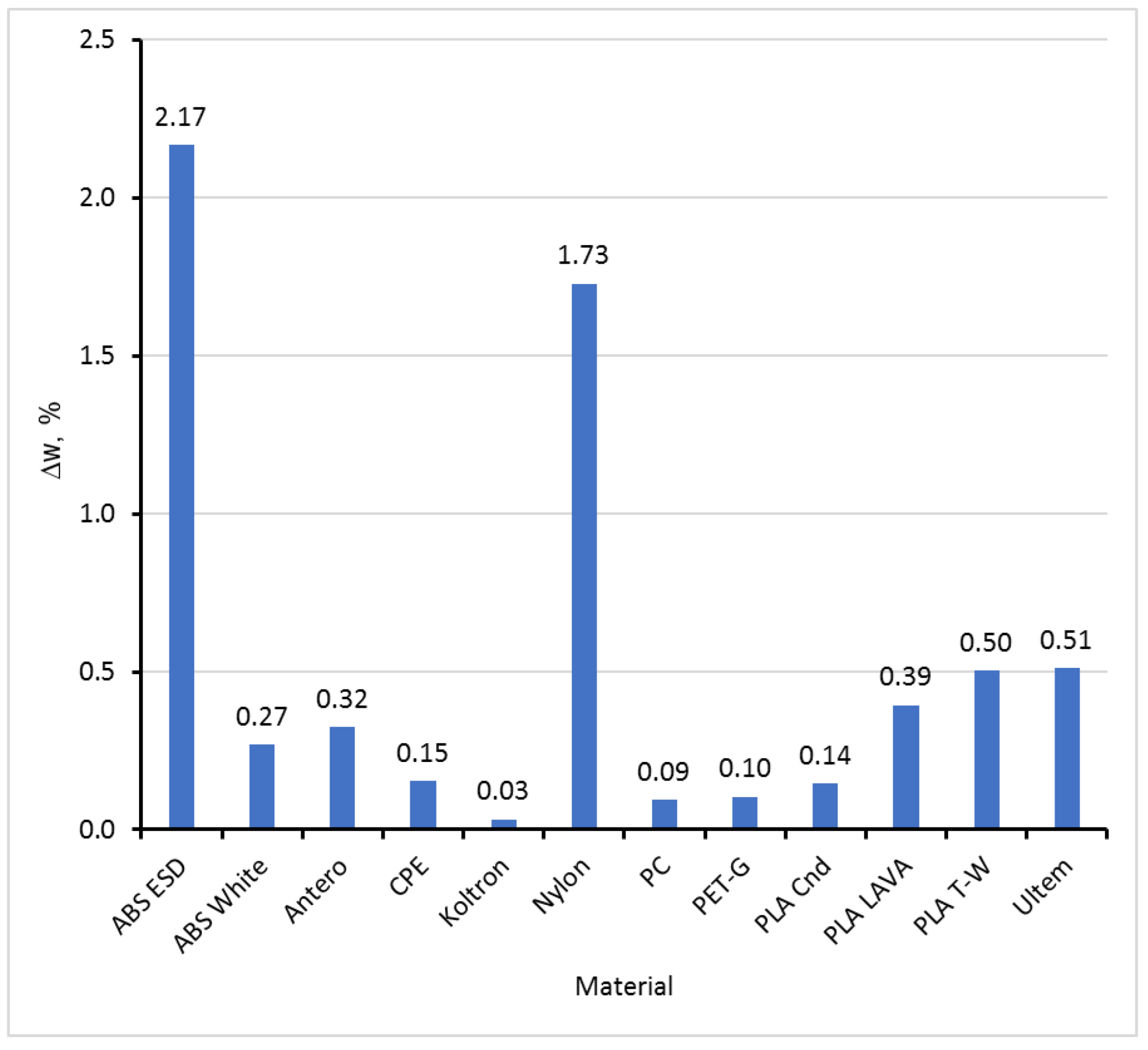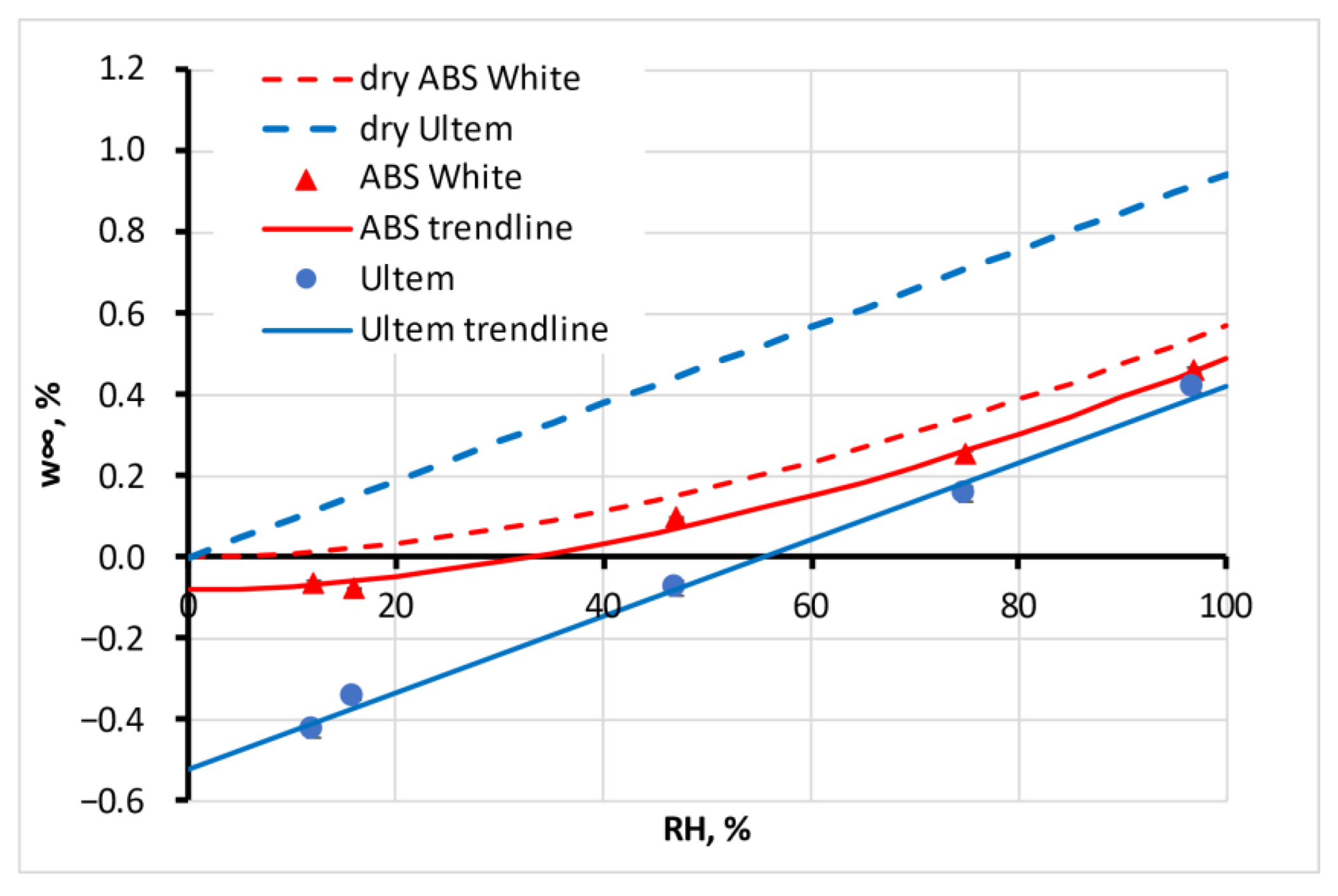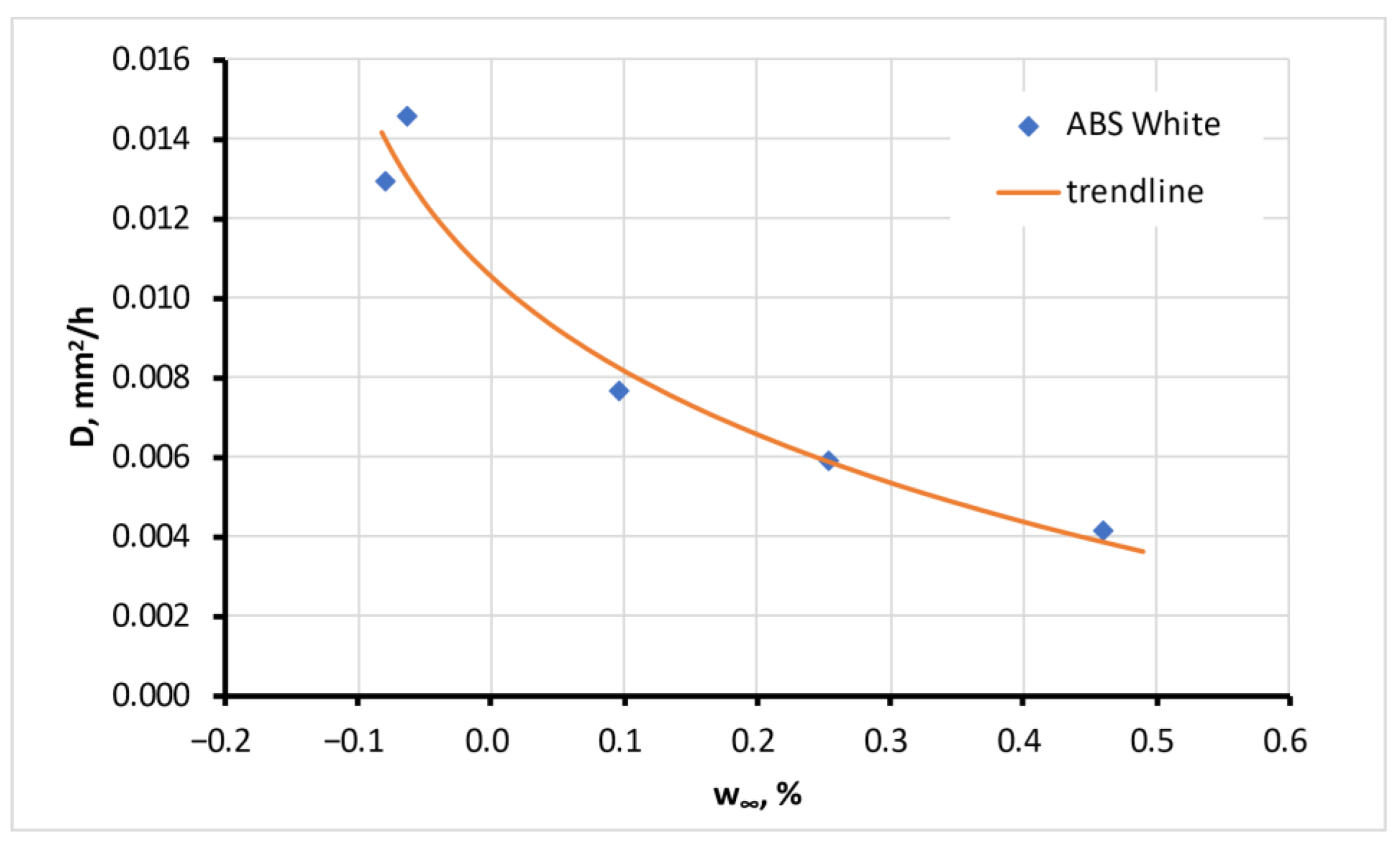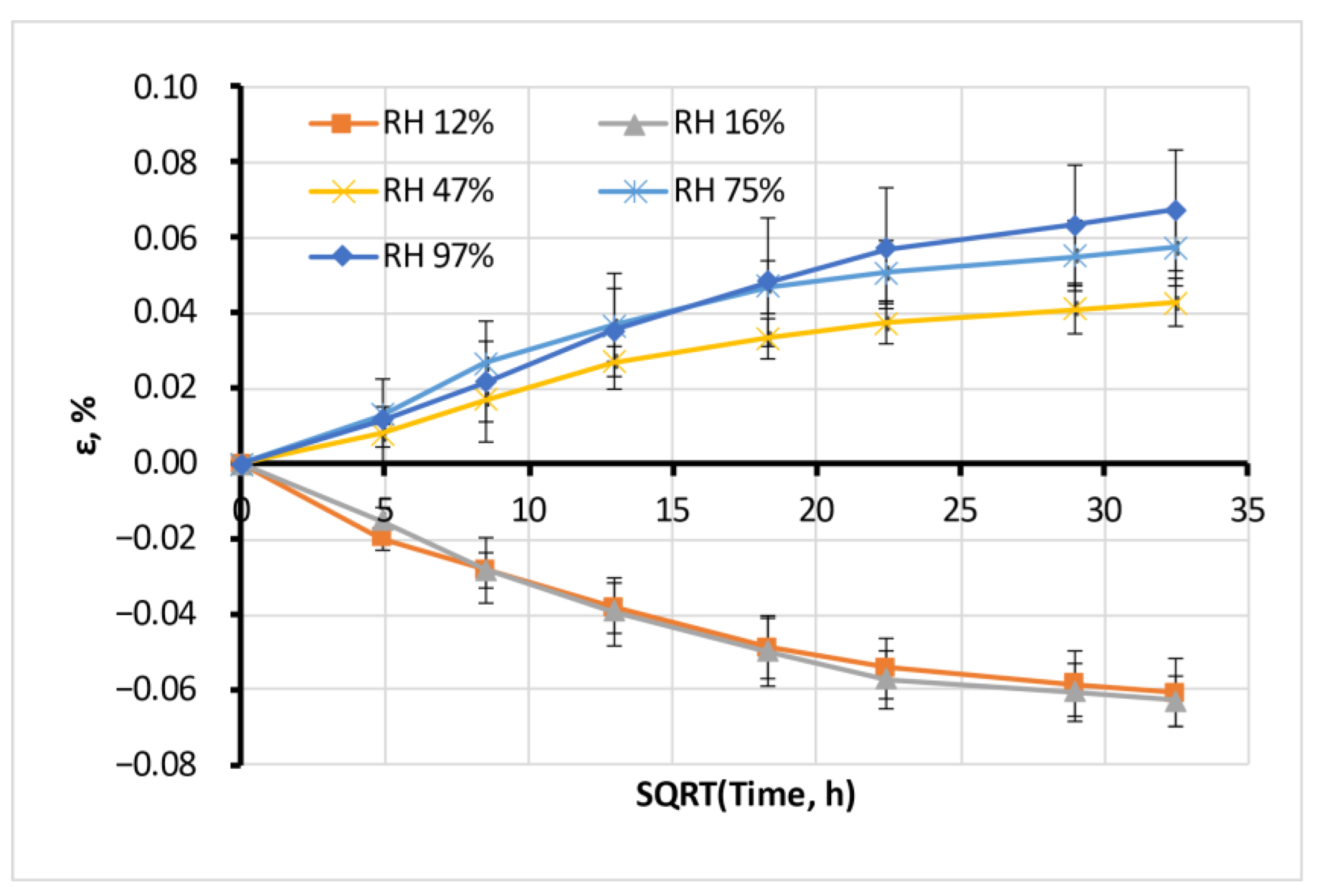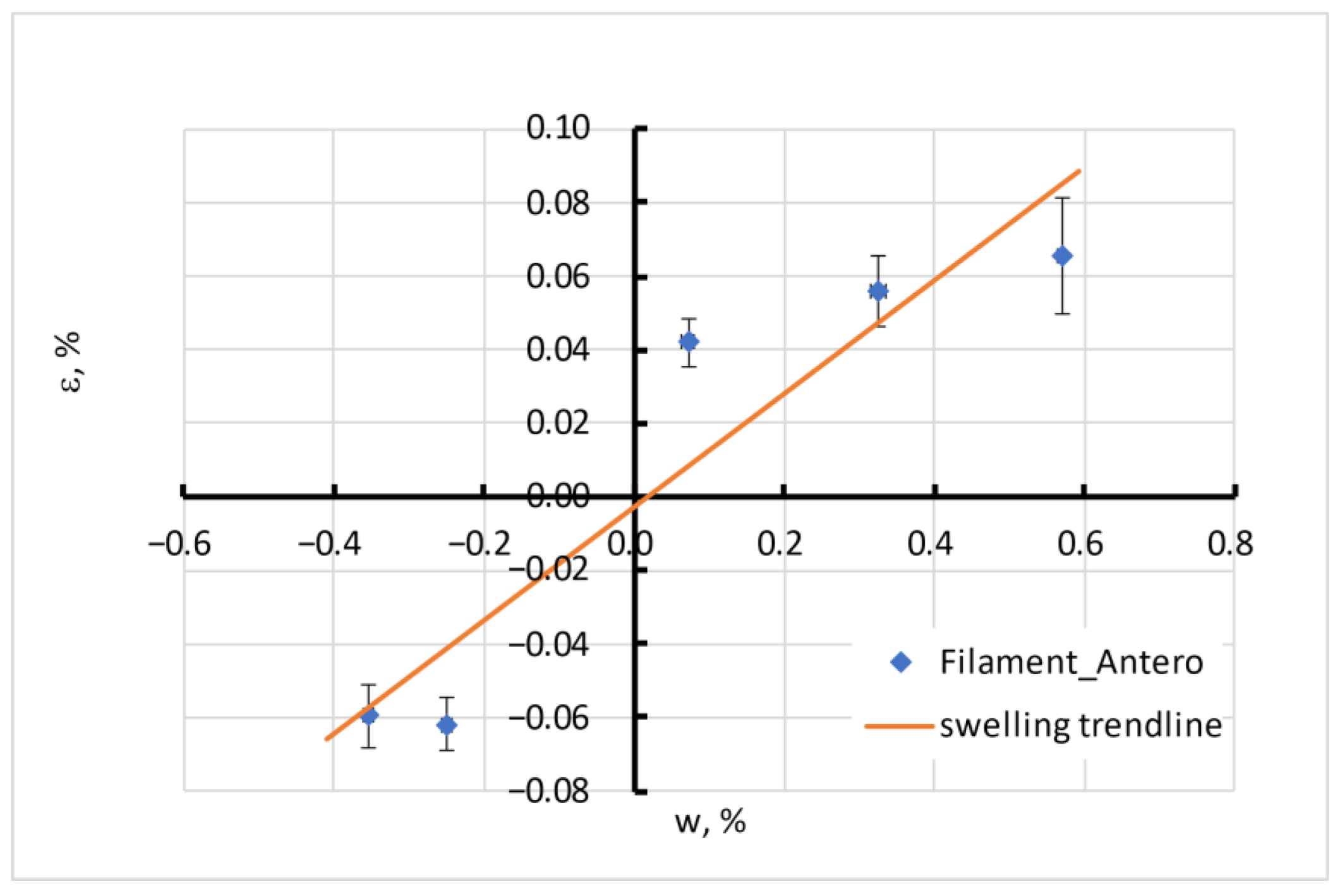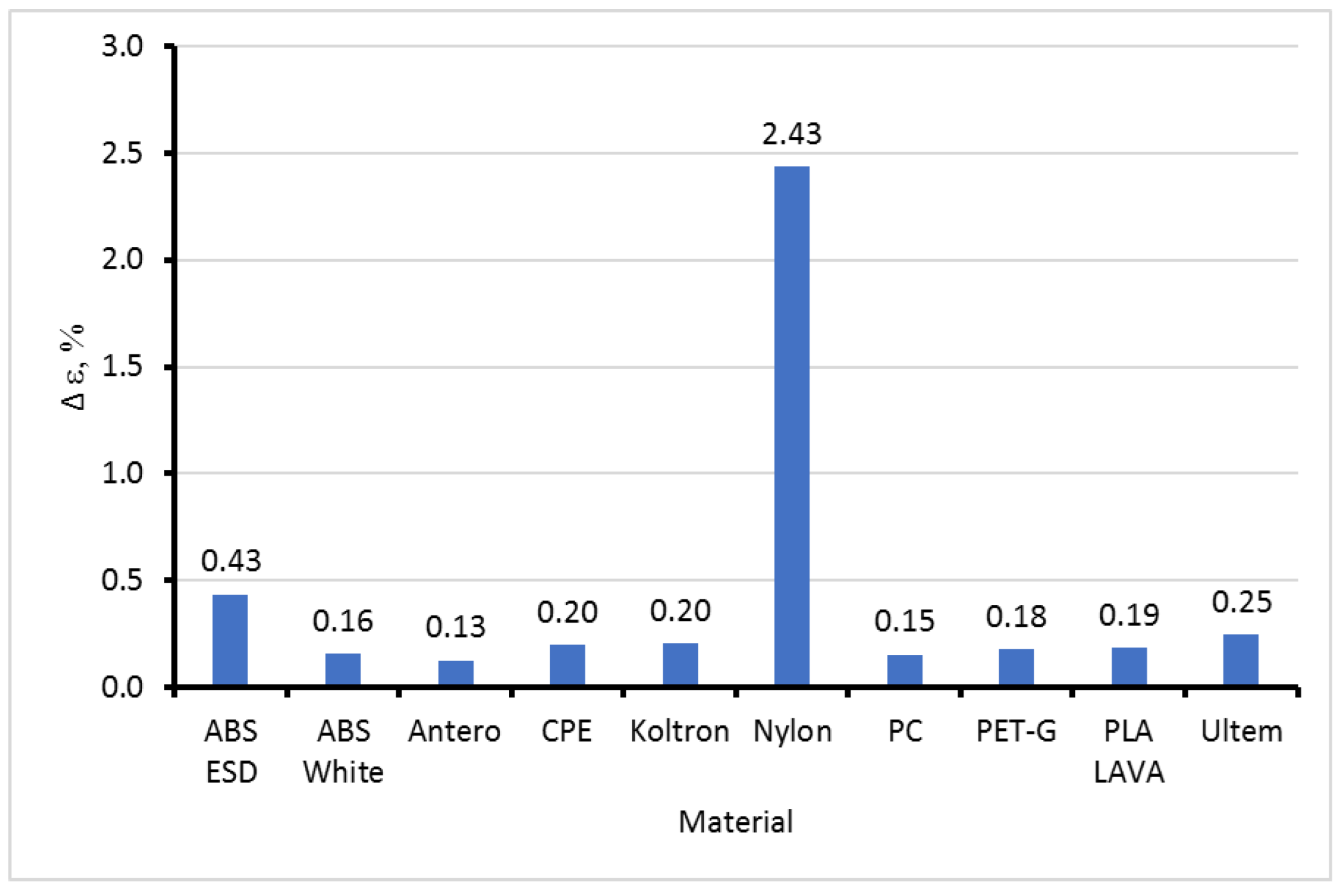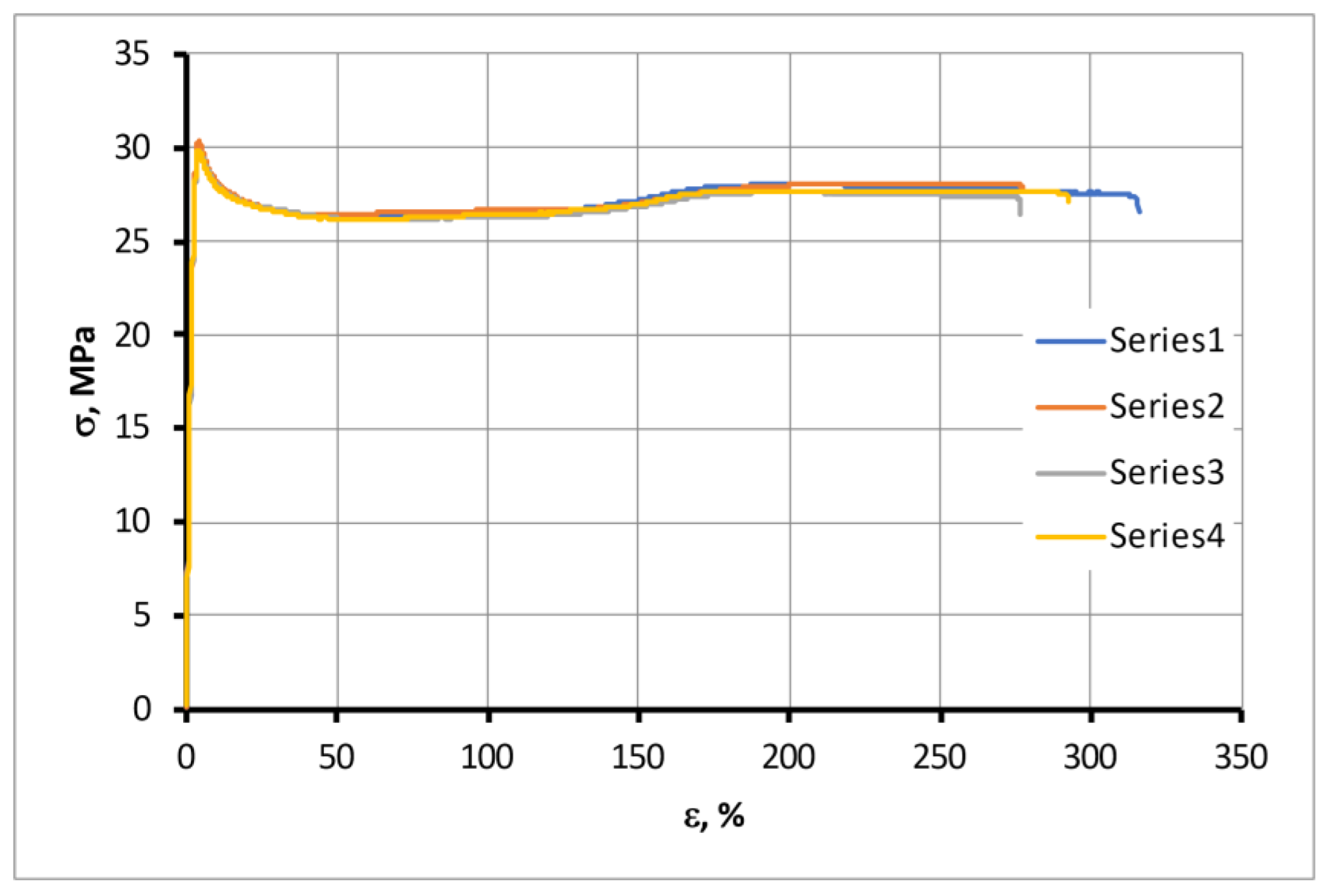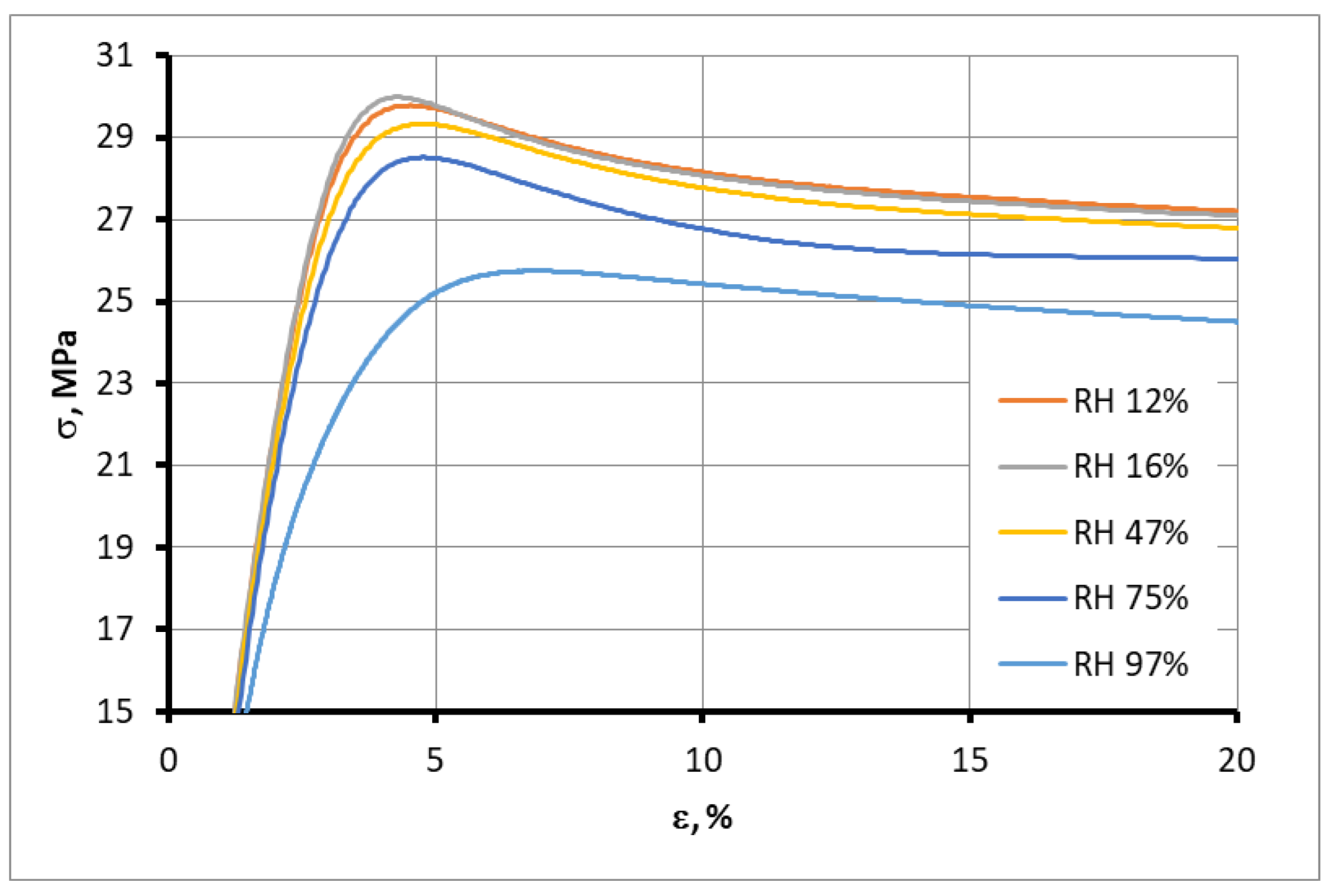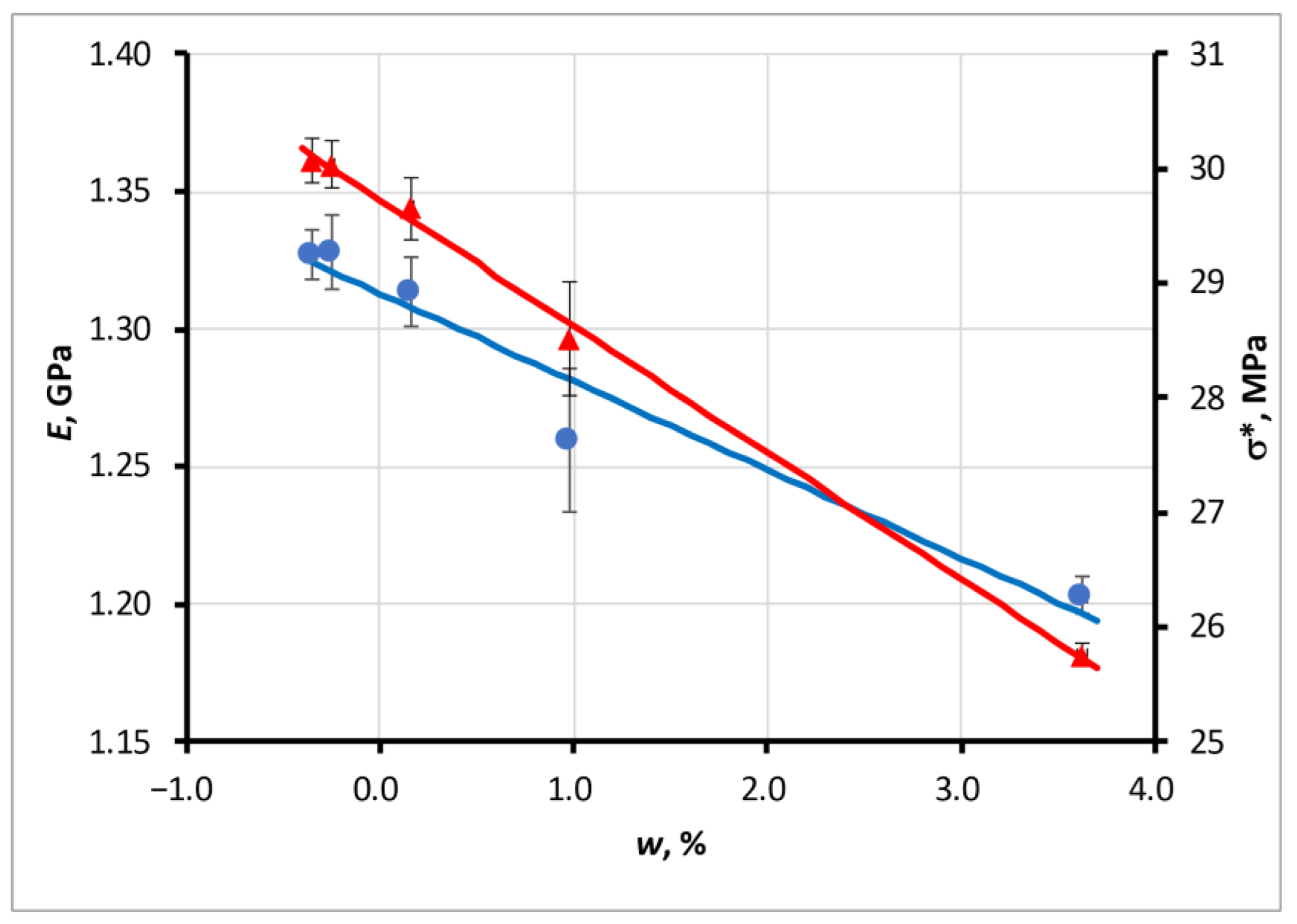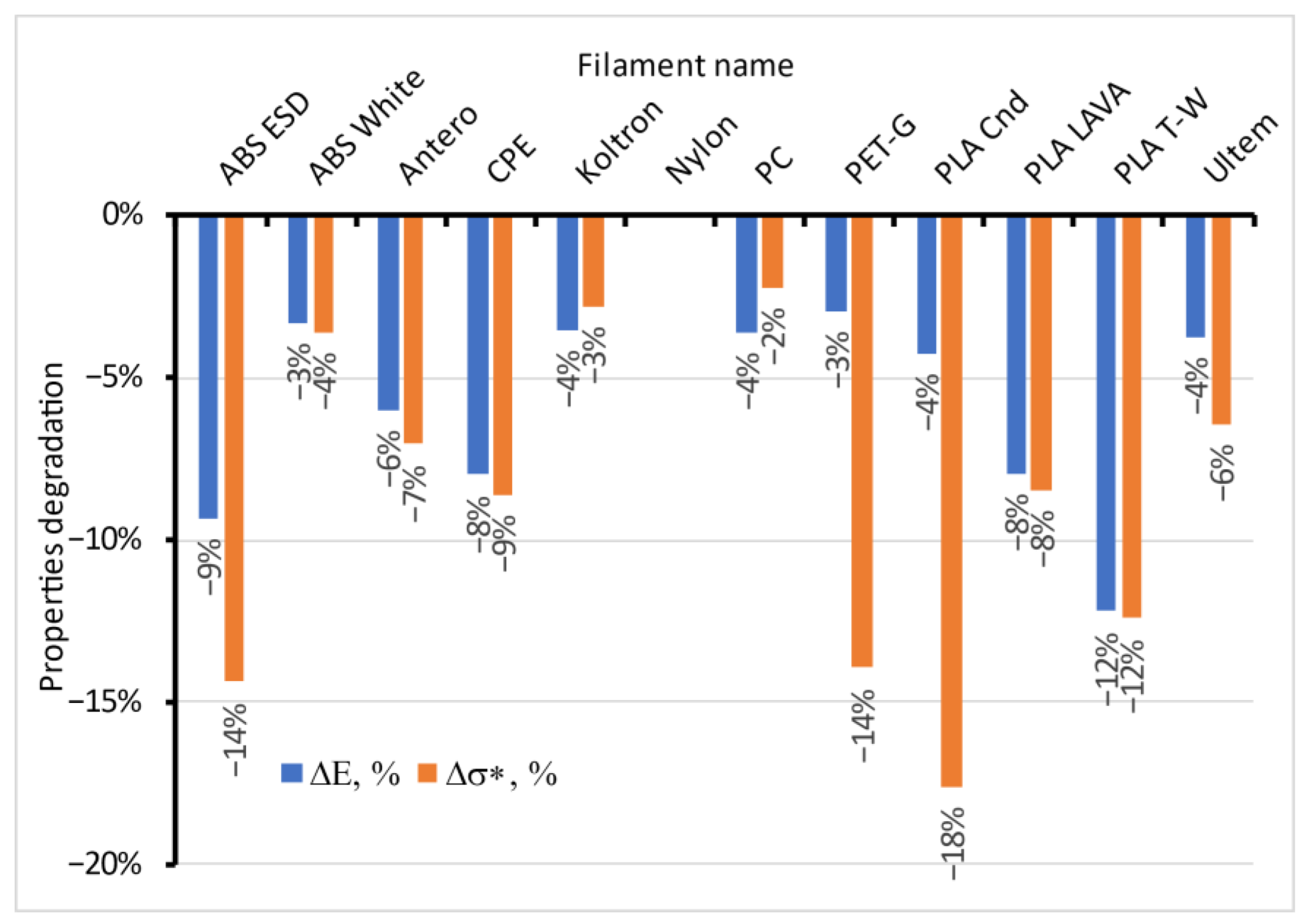1. Introduction
Additive manufacturing, widely known as 3D printing, is a modern technology that has experienced constant growth in recent decades. It is also referred to as one of the trends of Industry 4.0 [
1]. One of the AM technologies, known as fused filament fabrication (FFF), has great potential for engineers and designers and allows the creation of unique complex-shape polymer constructions within relative time limits [
2,
3]. FFF technology is based on a layer-by-layer layup of extruded polymer material, referred to as filament. The filament materials range from pure polymers to those reinforced with nanoparticles, fibres, etc., responding to planned applications [
4]. Generally, polymer materials used as a filament base can be divided into home/laboratory use and industrial use [
5]. Materials for home/laboratory use are more straightforward in terms of printing and processing but are more sensitive to environmental factors [
6] and do not have outstanding mechanical and physical properties [
7]. Such materials could be used for prototyping and producing parts for single use and for studying the material properties [
8]. The main materials used in this group are polylactic acid (PLA), acrylonitrile butadiene styrene (ABS), polycarbonate (PC), and polyamide (PA, Nylon). On the other hand, materials for industrial printing such as polyetherimide (PEI) and polyetherketoneketone (PEKK) materials, or a combination of them [
9,
10], have more advanced properties, are not so sensitive to external factors, and could be used for more practical applications [
11].
Three-dimensional printing using the FFF method is swiftly moving from prototyping to functional parts, thus facing new practical challenges. Most traditional polymers and composites used for structural applications are moisture-sensitive, tend to absorb humidity, and lose stiffness and strength in a moist environment [
12,
13]. FFF filaments are expected to behave similarly. Thus, this affects the printing parameters [
6] and properties of the 3D-printed structures [
14,
15].
Filaments shipped from manufacturers are vacuum-packed and are in relatively stable conditions before opening. The mechanical, physical, and other properties mentioned in the datasheet should correspond to these reference, “ideal” conditions. After unsealing, filaments tend to sorb the moisture from the ambient atmosphere, which is typically not controlled. Frequently, only specialised 3D printing companies closely monitor the storage conditions of unsealed filaments during the storing and printing period. For example, such companies use a 3D printing filament storage cabinet or at least a silica-gel-containing storage box. In most room conditions, filaments are subjected to an atmosphere of 20–50% relative humidity (RH). Filaments absorb water from the air, swell, and degrade in such conditions. Even following the rules during storage for filaments, a coil is removed from the safety conditions, and the filament is subjected to humidity because most desktop-type printers are not equipped with a specific “humidity-safe” place or dry box for coil storage during the printing period.
Despite the wide range of work devoted to studying the properties of printed parts and printing parameters, a gap in the information is observed when it comes to studies of the main component—a filament.
One of the possible ways to investigate the effect of moisture on the mechanical properties of FFF structures is the so-called structural approach, well known in the mechanics of fibre-reinforced composites and also applied to moisture sorption processes [
16]. In this way, the experimental investigation and modelling of filament moisture sorption are crucial. The sorption of various materials such as PLA, SiC-filled PLA composites, ABS [
17], PC/ABS blend, and Nylon [
18] was studied. The results showed that the sorption of samples was strongly affected by the manufacturing method [
19,
20]. Thus, these data are not applicable for sorption modelling in contrast to the sorption data of specific filaments. Unfortunately, systematised comparative research devoted to filaments is missing in the literature.
On the other hand, the moisture sorption process and its effect on the mechanical properties of composites are well investigated. The effect of moisture on the elastic and viscoelastic properties of epoxy and epoxy-based carbon-fibre-reinforced plastic filled with multiwall carbon nanotubes was described in [
21]. The effects of moisture on the elastic and viscoelastic properties of CFRP rebars and vinyl ester binder are described in [
22]. The hydrothermal ageing of an epoxy resin filled with carbon nanofillers is described in [
23]. These attempts should be extended to FFF materials and structures.
This research aimed to conduct an experimental investigation and model the water sorption process of typical polymer filaments used for FFF in order to obtain the data necessary for the further prediction of the effect of moisture on the properties of FFF structures. To achieve this aim, four tasks were formulated: (1) To perform experimental research on the moisture sorption process of some typical filaments used for FFF. (2) To model the moisture sorption process and obtain the material parameters that characterised the process. (3) To evaluate the swelling of the filaments in wet environments. (4) To estimate the possible degree of degradation of the mechanical properties of the filaments due to moisture absorption.
2. Moisture Sorption by a Cylindrical Specimen
Let us consider the well-known Fick’s second equation [
24,
25] for the case of the moisture diffusion (sorption) process in a cylindrical polymer specimen
where
U is the moisture concentration in the specimen,
D is the diffusion coefficient, and
t is time. The cylindrical coordinates are
r and
z only. The initial moisture concentration distribution in the specimen is
φ (
r, z), and the concentration on the specimen surface is
U0. Equation (1) with initial and border conditions could be rewritten as
The above-mentioned classical books provide the solution to the diffusion problem for an infinite-length cylinder. Many authors often use it to model the moisture sorption process in long fibres [
26,
27]. For the case of a bounded cylinder, instead of (2), we have
with the initial condition
and the border condition
A complete step-by-step solution of the problem using the method of the separation of variables is given in
Appendix A.
As a result, the moisture content in a cylindrical sample could be calculated as
The roots,
γk, of the zero Bessel function are also given in
Appendix A.
A user-defined function was developed in Microsoft Excel using Visual Basic for Applications (VBA) programming language to calculate moisture content in a cylindrical sample using (5).
A large number of summands (up to
k = 30) in expression (5) provides convergence of the equation for relatively small time values close to zero, as seen in
Figure 1. For the prediction of the moisture sorption process at the final stage, when the moisture content of a sample is 80% of the equilibrium or more, the sum could be restricted only to the first term of the series to obtain the simple expression
This expression provides 98% or better accuracy for Fo > 0.004, which is enough for many evaluations.
The moisture sorption rate depends on the geometry of the sample. A calculated graph of moisture sorption for cylinders with different length-to-radius ratios
l/
R is presented in
Figure 2. It is seen from the figure that for short cylinders with
l/
R < 2 (disk shape), the contribution of the axial component in the sorption process is essential. The one-dimensional solution with only the radial component gives an underestimated prediction for such cases. For modelling purposes, the equilibrium moisture content in this calculation was chosen and fixed as
w∞ = 1, but this does not matter for such evaluation.
3. Materials and Methods
A list of tested materials is given in
Table 1. Representatives of the most often used filament classes were tested. Some materials with additional functionality, such as electrical conductivity (Koltron, PLA Cnd, ABS ESD) or a thermochromatic effect (PLA LAVA), were also included in the list. The fillers that provide this additional functionality can notably influence the properties of basic polymers; however, these effects are beyond the scope of the present study. Most of the tested thermoplastics are hydrophobic materials, excluding Nylon and CPE, which are hydrophilic, as indicated in the technical data sheets. This information is not available for materials with additives.
The categories of tested materials include common, engineering, functional, and high-performance plastics, as presented in
Figure 3. This division is often used but is relatively conventional, and white horizontal lines in the figure are not sharp borders between the categories. The white vertical line in the figure is also not a sharp border between amorphous and semi-crystalline. Additionally, the horizontal and vertical arrows do not indicate any degree of crystallinity or the scale of price or performance, but only growth directions. The 13 tested polymers have different chemical formulations and molecular and sub-molecular structures that could change with moisture sorption. Their moisture sorption behaviour and degradation of properties also are different, though they should be classified using the obtained results.
All filaments were stored in the producer’s vacuum package with silica gel to prevent filament exposure to humid air before the start of experiments. Two types of samples were prepared and tested: “short” cylinders of
l = 4 mm marked with an asterisk (*), as given in
Table 1, and “long” cylinders with a length of
l = 100 mm (all materials are listed in the table, except ABS Black). The nominal diameter of the filaments was 2
R = 2.8 mm (except Ultem and Antero, with a diameter of 2
R = 1.75 mm). “Short” cylinders were intended for accelerated moisture sorption tests, while “long” cylinders, in turn, were for long-term sorption, swelling, and mechanical tests. All samples were cut with a knife and the cylinder ends were polished.
Moisture sorption experiments were performed in desiccators with varying levels of RH of the atmosphere created using silica gel (12%) and saturated salt solutions: LiCl (16%), KSCN (47%), NaCl (75%), and K
2SO
4 (97%). From 10 to 15 “short” and 5 “long” cylinder samples were placed in each desiccator. Silica gel was dried in an oven at a temperature of 150 °C for 3 h. A datalogger Extech Instrument RHT10 (Extech Instruments, NH, USA) was used to control the humidity, temperature, and dew-point values in the desiccators. It was revealed that after a desiccator lid was opened during the experiment, it took up to 20 h to restore the moisture environment in the desiccator after closure. The mass of the samples was controlled only once per day at the initial stage of the sorption process and later once per week using the Mettler-Toledo XS205DU Analytical Balance Scale (Mettler-Toledo, Switzerland) range 81/220 g with an accuracy of ± 0.00001 g. The relative water content of a sample
w(
t) was calculated using the equation
where
m(
t) and
m0 are the current and initial mass of a sample.
The samples were considered to be in the equilibrium state if small mass oscillations were observed only around a value during a certain time interval, which was approximately the same as that of the sorption process. All moisture content values during the interval were averaged and considered as the equilibrium moisture content.
The length of “long” cylinders was measured for swelling calculations during moisture sorption experiments. A Mitutoyo Absolute digital micrometre 100–125 mm (Mitutoyo, Japan) with a precision of ± 0.001 mm was used for the measurements. This parameter has quite a big scatter in terms of its physical nature because the length of a sample changes by ca. 0.1% or less. Multiple length measurements for “long” samples were performed to reduce the data scatter.
Mechanical tensile tests of filaments moistened in a humid atmosphere till equilibrium were performed on the ZWICK 2.5 machine (ZwickRoell GmbH, Germany) with a 10 mm/min crosshead displacement rate. The tensile strain was measured by grip-to-grip separation with a nominal distance of 50 mm. A pre-load of 1 N was applied to all samples. The elastic modulus was calculated in the strain range of 0.05–0.25%. The tensile test duration till fracture depended on the material, but it was less than 1 min. Thus, the mass loss of absorbed moisture was neglected during the test. Three to five moistened specimens were tested for each material and each environment, and the average data were used.
